University Report: Economic Status Impact on Type 2 Diabetes Treatment
VerifiedAdded on 2021/05/31
|7
|1509
|76
Report
AI Summary
This report examines the impact of economic status on the treatment of Type 2 diabetes, focusing on a case study of an Aboriginal individual, Kevin, diagnosed with the condition. It explores how socioeconomic factors, such as low income and cultural determinants, influence access to healthcare, including diabetes education, specialist referrals, and medication adherence. The report highlights the disparities in care, with lower-income individuals facing challenges related to food security, health literacy, and access to multidisciplinary healthcare teams. It also considers the role of cultural determinants, such as the patient's Aboriginal background, and how these factors contribute to health outcomes. The analysis incorporates references to relevant research, emphasizing the need for a holistic approach to diabetes care that addresses both economic and cultural barriers to improve patient outcomes.
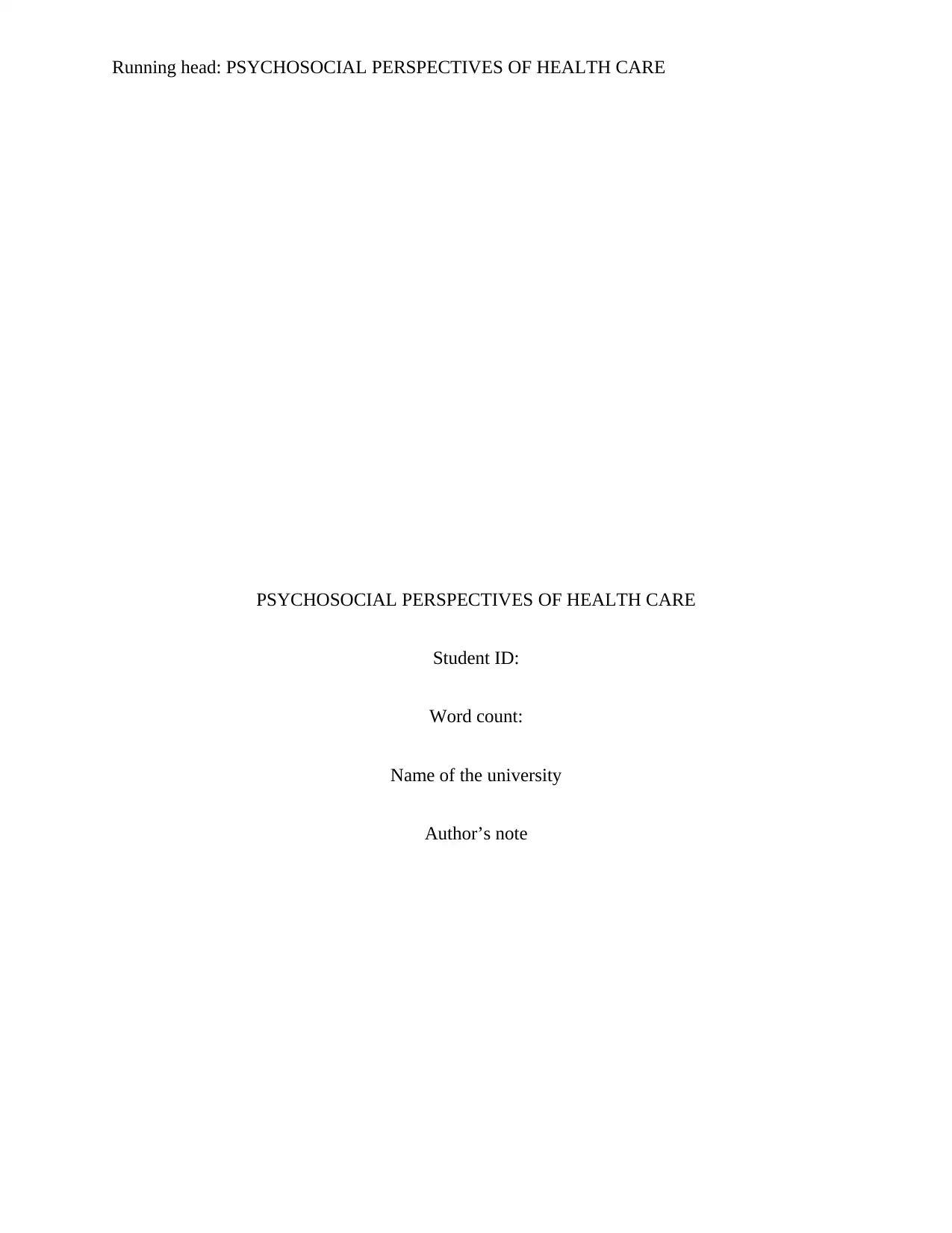
Running head: PSYCHOSOCIAL PERSPECTIVES OF HEALTH CARE
PSYCHOSOCIAL PERSPECTIVES OF HEALTH CARE
Student ID:
Word count:
Name of the university
Author’s note
PSYCHOSOCIAL PERSPECTIVES OF HEALTH CARE
Student ID:
Word count:
Name of the university
Author’s note
Paraphrase This Document
Need a fresh take? Get an instant paraphrase of this document with our AI Paraphraser
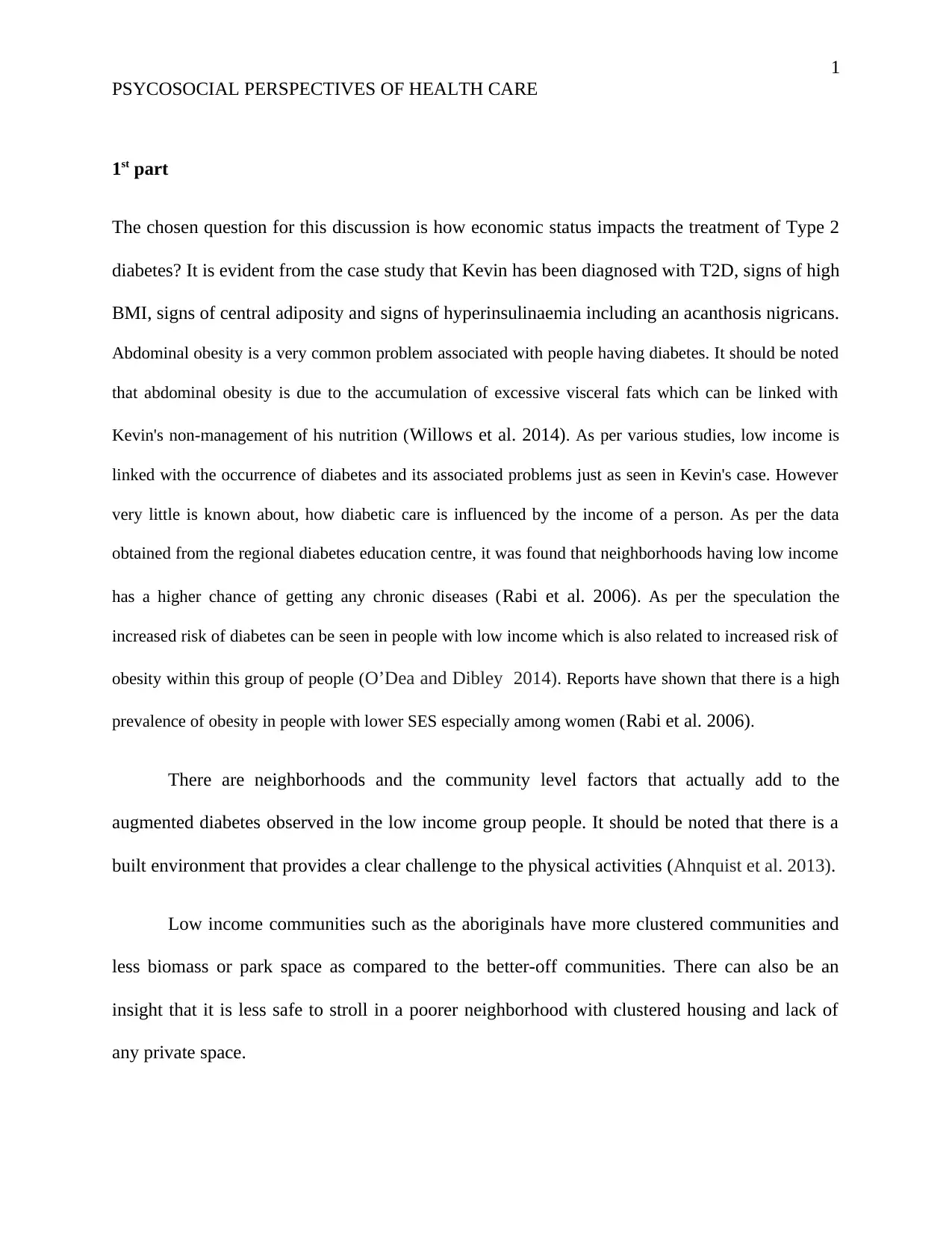
1
PSYCOSOCIAL PERSPECTIVES OF HEALTH CARE
1st part
The chosen question for this discussion is how economic status impacts the treatment of Type 2
diabetes? It is evident from the case study that Kevin has been diagnosed with T2D, signs of high
BMI, signs of central adiposity and signs of hyperinsulinaemia including an acanthosis nigricans.
Abdominal obesity is a very common problem associated with people having diabetes. It should be noted
that abdominal obesity is due to the accumulation of excessive visceral fats which can be linked with
Kevin's non-management of his nutrition (Willows et al. 2014). As per various studies, low income is
linked with the occurrence of diabetes and its associated problems just as seen in Kevin's case. However
very little is known about, how diabetic care is influenced by the income of a person. As per the data
obtained from the regional diabetes education centre, it was found that neighborhoods having low income
has a higher chance of getting any chronic diseases (Rabi et al. 2006). As per the speculation the
increased risk of diabetes can be seen in people with low income which is also related to increased risk of
obesity within this group of people (O’Dea and Dibley 2014). Reports have shown that there is a high
prevalence of obesity in people with lower SES especially among women (Rabi et al. 2006).
There are neighborhoods and the community level factors that actually add to the
augmented diabetes observed in the low income group people. It should be noted that there is a
built environment that provides a clear challenge to the physical activities (Ahnquist et al. 2013).
Low income communities such as the aboriginals have more clustered communities and
less biomass or park space as compared to the better-off communities. There can also be an
insight that it is less safe to stroll in a poorer neighborhood with clustered housing and lack of
any private space.
PSYCOSOCIAL PERSPECTIVES OF HEALTH CARE
1st part
The chosen question for this discussion is how economic status impacts the treatment of Type 2
diabetes? It is evident from the case study that Kevin has been diagnosed with T2D, signs of high
BMI, signs of central adiposity and signs of hyperinsulinaemia including an acanthosis nigricans.
Abdominal obesity is a very common problem associated with people having diabetes. It should be noted
that abdominal obesity is due to the accumulation of excessive visceral fats which can be linked with
Kevin's non-management of his nutrition (Willows et al. 2014). As per various studies, low income is
linked with the occurrence of diabetes and its associated problems just as seen in Kevin's case. However
very little is known about, how diabetic care is influenced by the income of a person. As per the data
obtained from the regional diabetes education centre, it was found that neighborhoods having low income
has a higher chance of getting any chronic diseases (Rabi et al. 2006). As per the speculation the
increased risk of diabetes can be seen in people with low income which is also related to increased risk of
obesity within this group of people (O’Dea and Dibley 2014). Reports have shown that there is a high
prevalence of obesity in people with lower SES especially among women (Rabi et al. 2006).
There are neighborhoods and the community level factors that actually add to the
augmented diabetes observed in the low income group people. It should be noted that there is a
built environment that provides a clear challenge to the physical activities (Ahnquist et al. 2013).
Low income communities such as the aboriginals have more clustered communities and
less biomass or park space as compared to the better-off communities. There can also be an
insight that it is less safe to stroll in a poorer neighborhood with clustered housing and lack of
any private space.
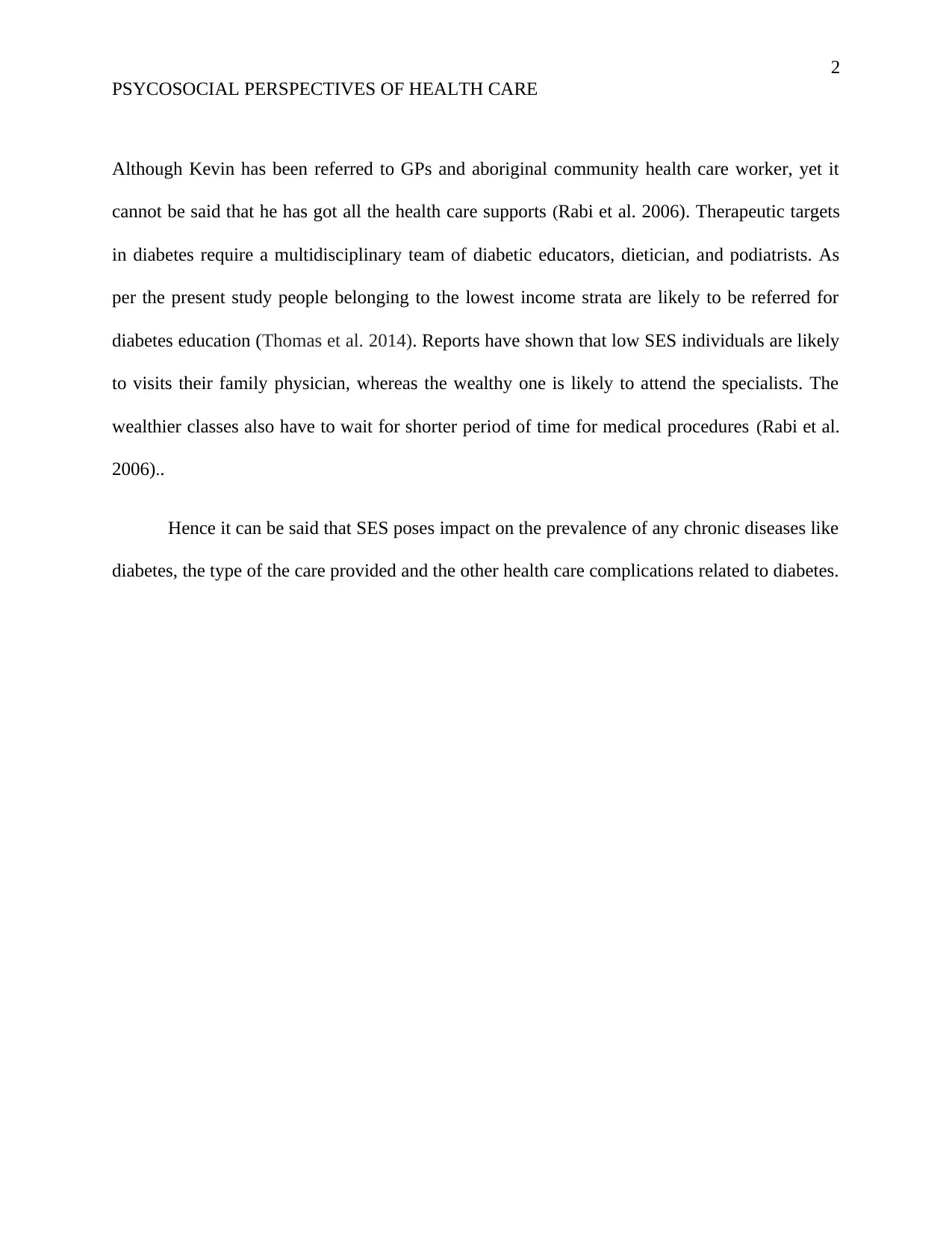
2
PSYCOSOCIAL PERSPECTIVES OF HEALTH CARE
Although Kevin has been referred to GPs and aboriginal community health care worker, yet it
cannot be said that he has got all the health care supports (Rabi et al. 2006). Therapeutic targets
in diabetes require a multidisciplinary team of diabetic educators, dietician, and podiatrists. As
per the present study people belonging to the lowest income strata are likely to be referred for
diabetes education (Thomas et al. 2014). Reports have shown that low SES individuals are likely
to visits their family physician, whereas the wealthy one is likely to attend the specialists. The
wealthier classes also have to wait for shorter period of time for medical procedures (Rabi et al.
2006)..
Hence it can be said that SES poses impact on the prevalence of any chronic diseases like
diabetes, the type of the care provided and the other health care complications related to diabetes.
PSYCOSOCIAL PERSPECTIVES OF HEALTH CARE
Although Kevin has been referred to GPs and aboriginal community health care worker, yet it
cannot be said that he has got all the health care supports (Rabi et al. 2006). Therapeutic targets
in diabetes require a multidisciplinary team of diabetic educators, dietician, and podiatrists. As
per the present study people belonging to the lowest income strata are likely to be referred for
diabetes education (Thomas et al. 2014). Reports have shown that low SES individuals are likely
to visits their family physician, whereas the wealthy one is likely to attend the specialists. The
wealthier classes also have to wait for shorter period of time for medical procedures (Rabi et al.
2006)..
Hence it can be said that SES poses impact on the prevalence of any chronic diseases like
diabetes, the type of the care provided and the other health care complications related to diabetes.
⊘ This is a preview!⊘
Do you want full access?
Subscribe today to unlock all pages.

Trusted by 1+ million students worldwide
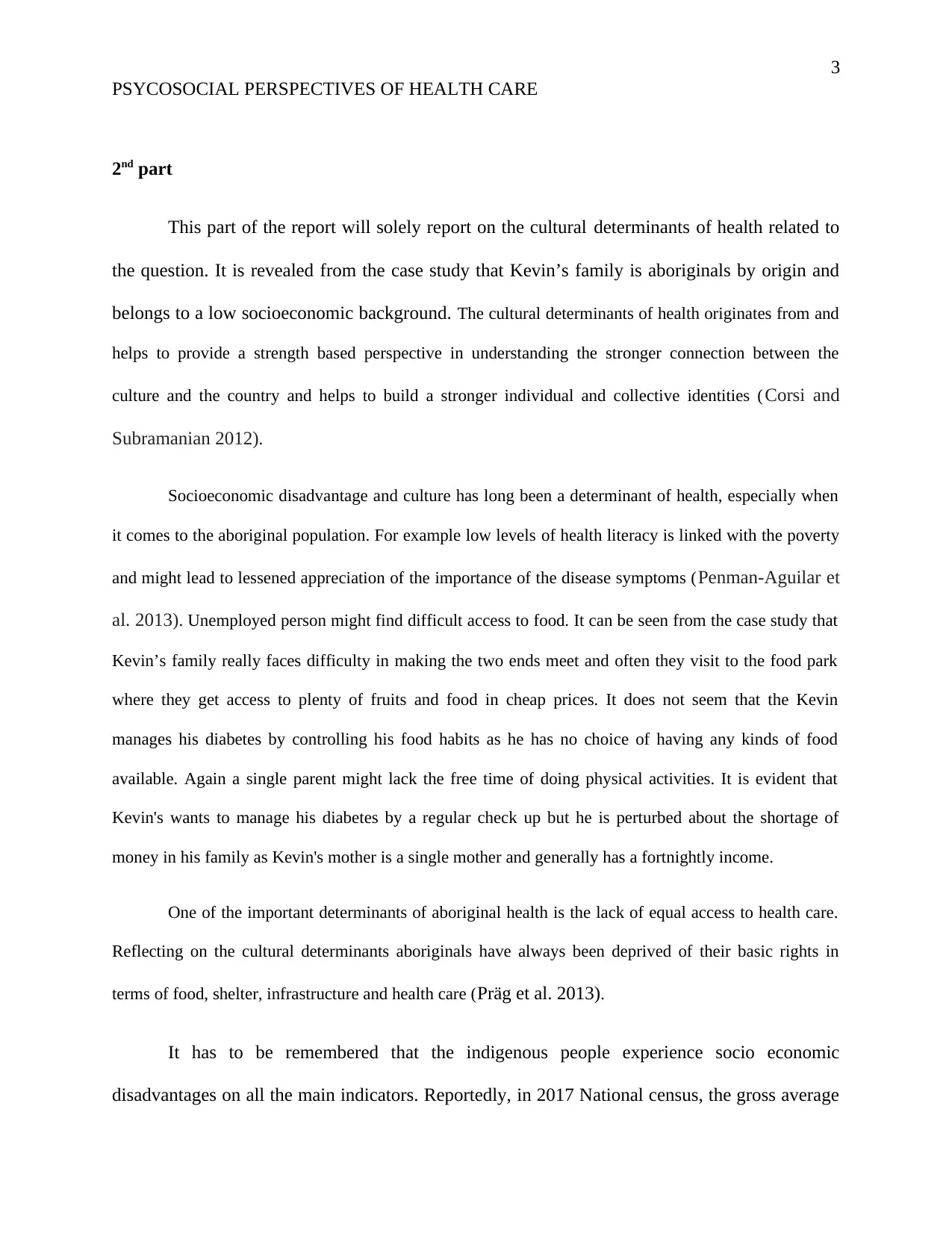
3
PSYCOSOCIAL PERSPECTIVES OF HEALTH CARE
2nd part
This part of the report will solely report on the cultural determinants of health related to
the question. It is revealed from the case study that Kevin’s family is aboriginals by origin and
belongs to a low socioeconomic background. The cultural determinants of health originates from and
helps to provide a strength based perspective in understanding the stronger connection between the
culture and the country and helps to build a stronger individual and collective identities ( Corsi and
Subramanian 2012).
Socioeconomic disadvantage and culture has long been a determinant of health, especially when
it comes to the aboriginal population. For example low levels of health literacy is linked with the poverty
and might lead to lessened appreciation of the importance of the disease symptoms (Penman-Aguilar et
al. 2013). Unemployed person might find difficult access to food. It can be seen from the case study that
Kevin’s family really faces difficulty in making the two ends meet and often they visit to the food park
where they get access to plenty of fruits and food in cheap prices. It does not seem that the Kevin
manages his diabetes by controlling his food habits as he has no choice of having any kinds of food
available. Again a single parent might lack the free time of doing physical activities. It is evident that
Kevin's wants to manage his diabetes by a regular check up but he is perturbed about the shortage of
money in his family as Kevin's mother is a single mother and generally has a fortnightly income.
One of the important determinants of aboriginal health is the lack of equal access to health care.
Reflecting on the cultural determinants aboriginals have always been deprived of their basic rights in
terms of food, shelter, infrastructure and health care (Präg et al. 2013).
It has to be remembered that the indigenous people experience socio economic
disadvantages on all the main indicators. Reportedly, in 2017 National census, the gross average
PSYCOSOCIAL PERSPECTIVES OF HEALTH CARE
2nd part
This part of the report will solely report on the cultural determinants of health related to
the question. It is revealed from the case study that Kevin’s family is aboriginals by origin and
belongs to a low socioeconomic background. The cultural determinants of health originates from and
helps to provide a strength based perspective in understanding the stronger connection between the
culture and the country and helps to build a stronger individual and collective identities ( Corsi and
Subramanian 2012).
Socioeconomic disadvantage and culture has long been a determinant of health, especially when
it comes to the aboriginal population. For example low levels of health literacy is linked with the poverty
and might lead to lessened appreciation of the importance of the disease symptoms (Penman-Aguilar et
al. 2013). Unemployed person might find difficult access to food. It can be seen from the case study that
Kevin’s family really faces difficulty in making the two ends meet and often they visit to the food park
where they get access to plenty of fruits and food in cheap prices. It does not seem that the Kevin
manages his diabetes by controlling his food habits as he has no choice of having any kinds of food
available. Again a single parent might lack the free time of doing physical activities. It is evident that
Kevin's wants to manage his diabetes by a regular check up but he is perturbed about the shortage of
money in his family as Kevin's mother is a single mother and generally has a fortnightly income.
One of the important determinants of aboriginal health is the lack of equal access to health care.
Reflecting on the cultural determinants aboriginals have always been deprived of their basic rights in
terms of food, shelter, infrastructure and health care (Präg et al. 2013).
It has to be remembered that the indigenous people experience socio economic
disadvantages on all the main indicators. Reportedly, in 2017 National census, the gross average
Paraphrase This Document
Need a fresh take? Get an instant paraphrase of this document with our AI Paraphraser
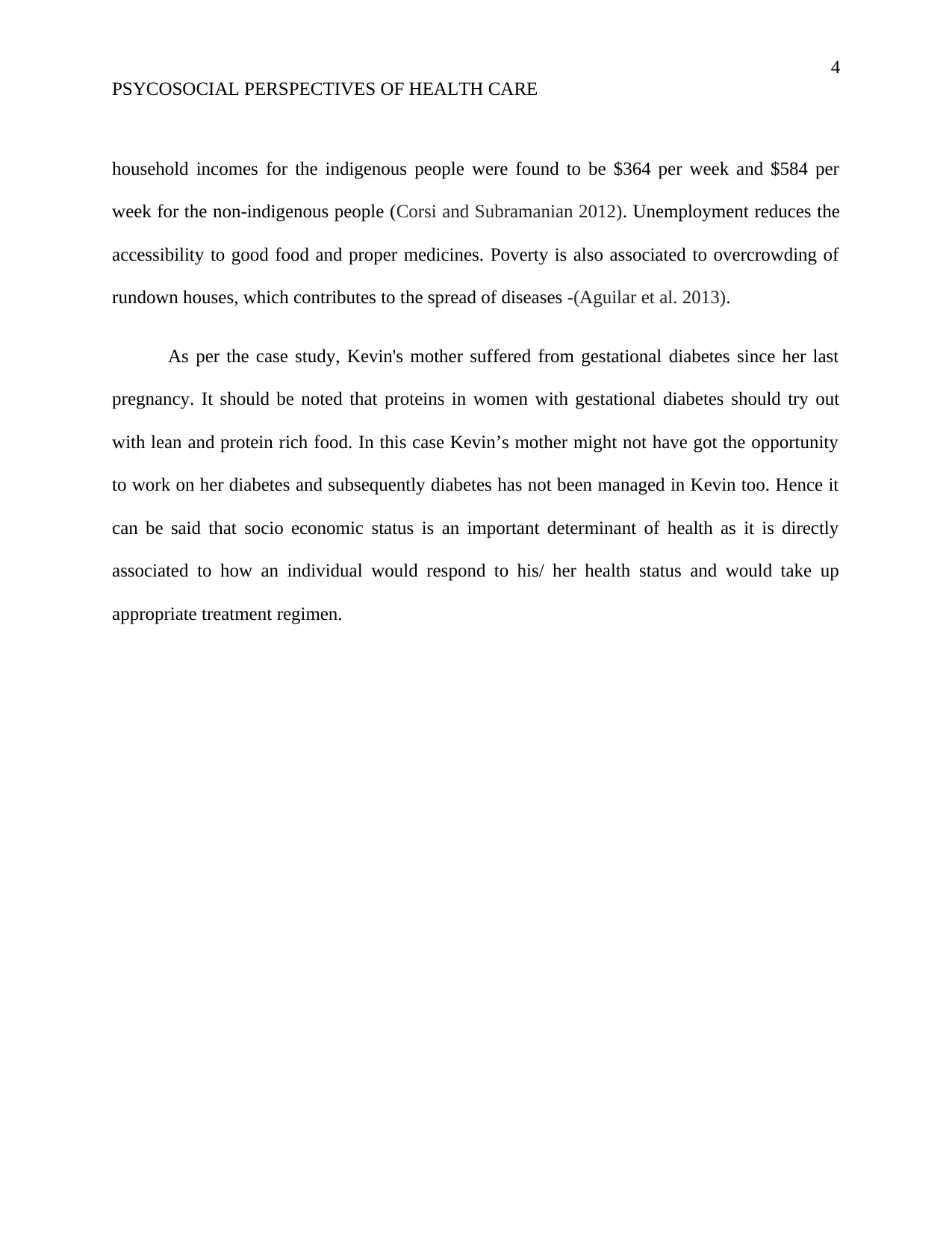
4
PSYCOSOCIAL PERSPECTIVES OF HEALTH CARE
household incomes for the indigenous people were found to be $364 per week and $584 per
week for the non-indigenous people (Corsi and Subramanian 2012). Unemployment reduces the
accessibility to good food and proper medicines. Poverty is also associated to overcrowding of
rundown houses, which contributes to the spread of diseases -(Aguilar et al. 2013).
As per the case study, Kevin's mother suffered from gestational diabetes since her last
pregnancy. It should be noted that proteins in women with gestational diabetes should try out
with lean and protein rich food. In this case Kevin’s mother might not have got the opportunity
to work on her diabetes and subsequently diabetes has not been managed in Kevin too. Hence it
can be said that socio economic status is an important determinant of health as it is directly
associated to how an individual would respond to his/ her health status and would take up
appropriate treatment regimen.
PSYCOSOCIAL PERSPECTIVES OF HEALTH CARE
household incomes for the indigenous people were found to be $364 per week and $584 per
week for the non-indigenous people (Corsi and Subramanian 2012). Unemployment reduces the
accessibility to good food and proper medicines. Poverty is also associated to overcrowding of
rundown houses, which contributes to the spread of diseases -(Aguilar et al. 2013).
As per the case study, Kevin's mother suffered from gestational diabetes since her last
pregnancy. It should be noted that proteins in women with gestational diabetes should try out
with lean and protein rich food. In this case Kevin’s mother might not have got the opportunity
to work on her diabetes and subsequently diabetes has not been managed in Kevin too. Hence it
can be said that socio economic status is an important determinant of health as it is directly
associated to how an individual would respond to his/ her health status and would take up
appropriate treatment regimen.
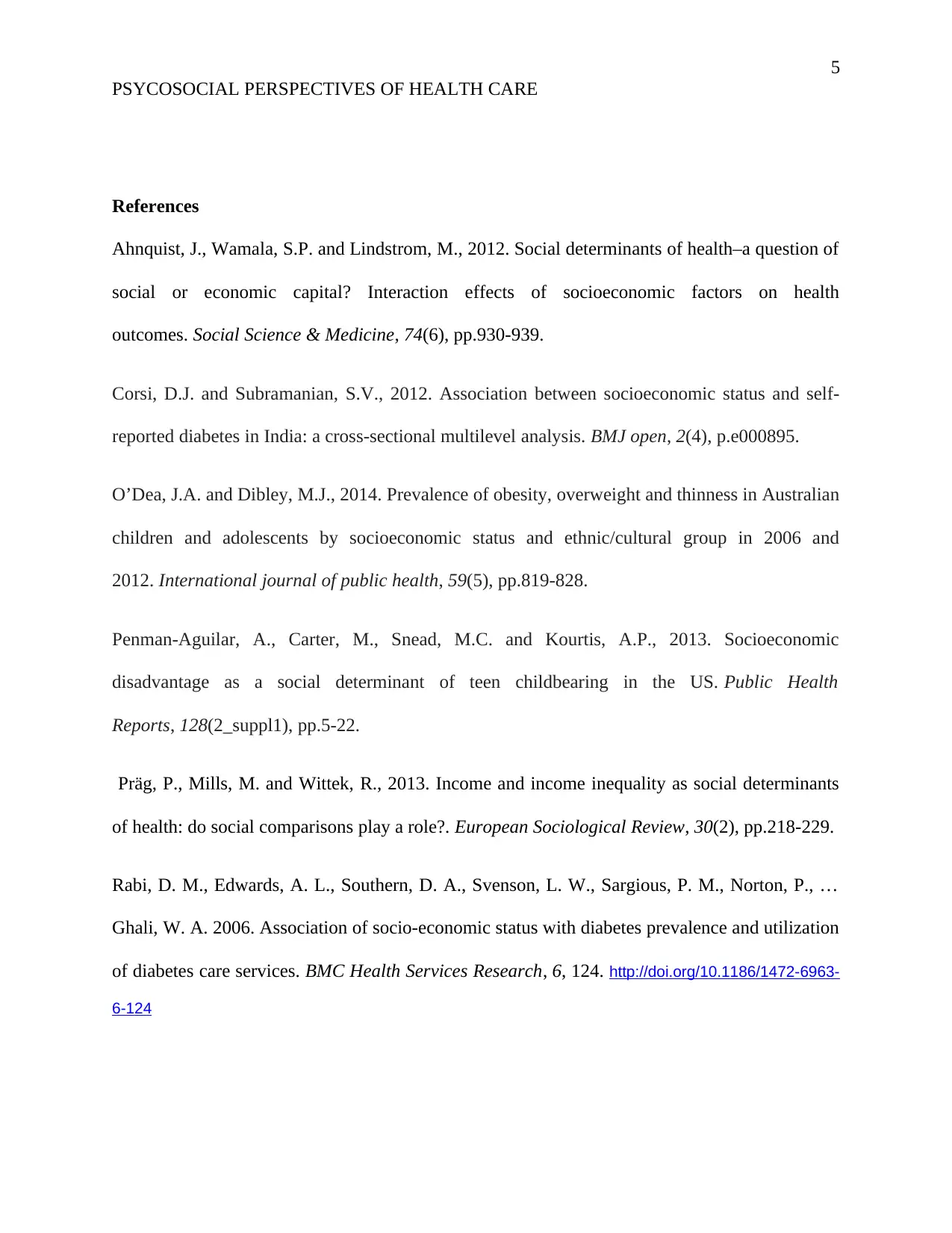
5
PSYCOSOCIAL PERSPECTIVES OF HEALTH CARE
References
Ahnquist, J., Wamala, S.P. and Lindstrom, M., 2012. Social determinants of health–a question of
social or economic capital? Interaction effects of socioeconomic factors on health
outcomes. Social Science & Medicine, 74(6), pp.930-939.
Corsi, D.J. and Subramanian, S.V., 2012. Association between socioeconomic status and self-
reported diabetes in India: a cross-sectional multilevel analysis. BMJ open, 2(4), p.e000895.
O’Dea, J.A. and Dibley, M.J., 2014. Prevalence of obesity, overweight and thinness in Australian
children and adolescents by socioeconomic status and ethnic/cultural group in 2006 and
2012. International journal of public health, 59(5), pp.819-828.
Penman-Aguilar, A., Carter, M., Snead, M.C. and Kourtis, A.P., 2013. Socioeconomic
disadvantage as a social determinant of teen childbearing in the US. Public Health
Reports, 128(2_suppl1), pp.5-22.
Präg, P., Mills, M. and Wittek, R., 2013. Income and income inequality as social determinants
of health: do social comparisons play a role?. European Sociological Review, 30(2), pp.218-229.
Rabi, D. M., Edwards, A. L., Southern, D. A., Svenson, L. W., Sargious, P. M., Norton, P., …
Ghali, W. A. 2006. Association of socio-economic status with diabetes prevalence and utilization
of diabetes care services. BMC Health Services Research, 6, 124. http://doi.org/10.1186/1472-6963-
6-124
PSYCOSOCIAL PERSPECTIVES OF HEALTH CARE
References
Ahnquist, J., Wamala, S.P. and Lindstrom, M., 2012. Social determinants of health–a question of
social or economic capital? Interaction effects of socioeconomic factors on health
outcomes. Social Science & Medicine, 74(6), pp.930-939.
Corsi, D.J. and Subramanian, S.V., 2012. Association between socioeconomic status and self-
reported diabetes in India: a cross-sectional multilevel analysis. BMJ open, 2(4), p.e000895.
O’Dea, J.A. and Dibley, M.J., 2014. Prevalence of obesity, overweight and thinness in Australian
children and adolescents by socioeconomic status and ethnic/cultural group in 2006 and
2012. International journal of public health, 59(5), pp.819-828.
Penman-Aguilar, A., Carter, M., Snead, M.C. and Kourtis, A.P., 2013. Socioeconomic
disadvantage as a social determinant of teen childbearing in the US. Public Health
Reports, 128(2_suppl1), pp.5-22.
Präg, P., Mills, M. and Wittek, R., 2013. Income and income inequality as social determinants
of health: do social comparisons play a role?. European Sociological Review, 30(2), pp.218-229.
Rabi, D. M., Edwards, A. L., Southern, D. A., Svenson, L. W., Sargious, P. M., Norton, P., …
Ghali, W. A. 2006. Association of socio-economic status with diabetes prevalence and utilization
of diabetes care services. BMC Health Services Research, 6, 124. http://doi.org/10.1186/1472-6963-
6-124
⊘ This is a preview!⊘
Do you want full access?
Subscribe today to unlock all pages.

Trusted by 1+ million students worldwide
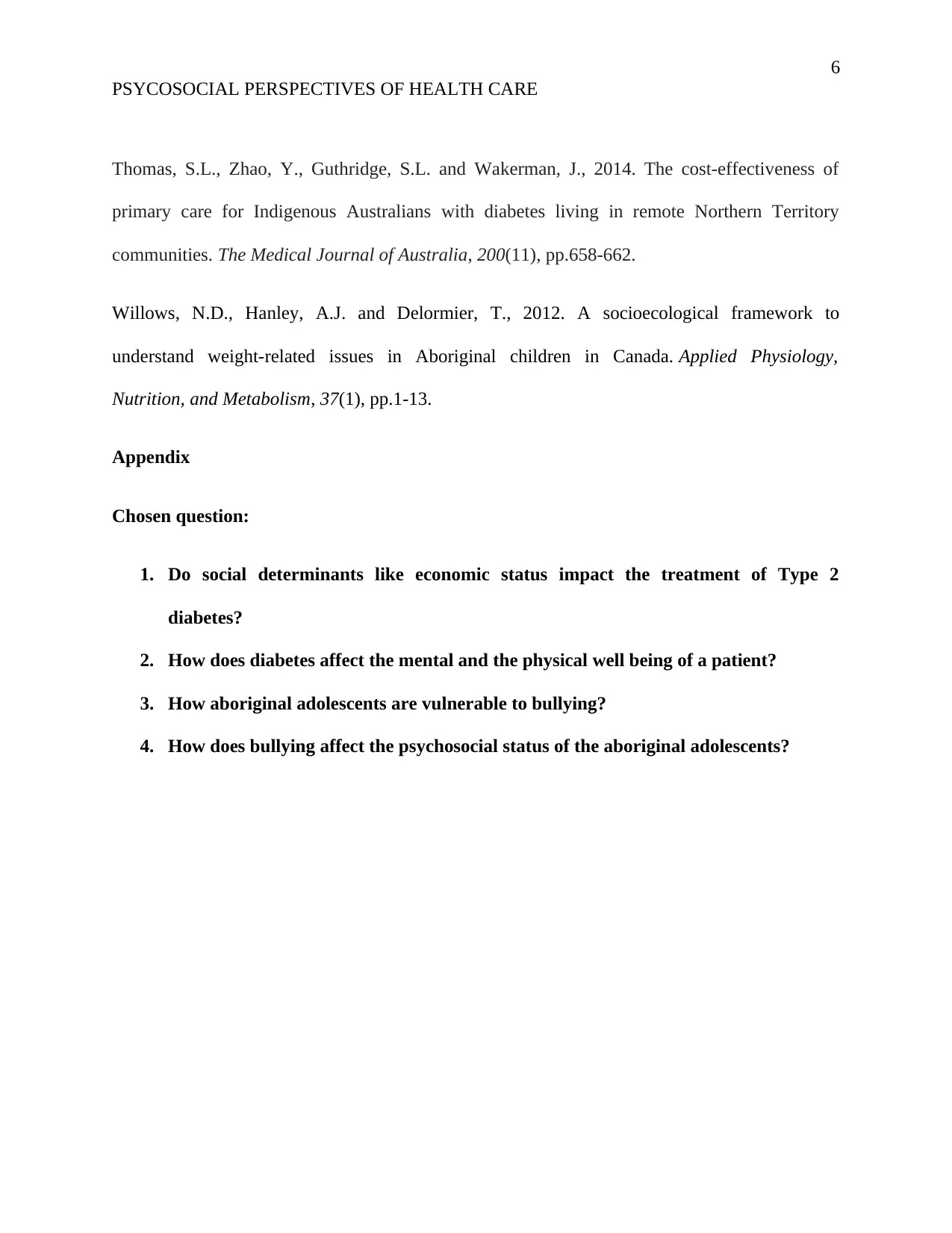
6
PSYCOSOCIAL PERSPECTIVES OF HEALTH CARE
Thomas, S.L., Zhao, Y., Guthridge, S.L. and Wakerman, J., 2014. The cost-effectiveness of
primary care for Indigenous Australians with diabetes living in remote Northern Territory
communities. The Medical Journal of Australia, 200(11), pp.658-662.
Willows, N.D., Hanley, A.J. and Delormier, T., 2012. A socioecological framework to
understand weight-related issues in Aboriginal children in Canada. Applied Physiology,
Nutrition, and Metabolism, 37(1), pp.1-13.
Appendix
Chosen question:
1. Do social determinants like economic status impact the treatment of Type 2
diabetes?
2. How does diabetes affect the mental and the physical well being of a patient?
3. How aboriginal adolescents are vulnerable to bullying?
4. How does bullying affect the psychosocial status of the aboriginal adolescents?
PSYCOSOCIAL PERSPECTIVES OF HEALTH CARE
Thomas, S.L., Zhao, Y., Guthridge, S.L. and Wakerman, J., 2014. The cost-effectiveness of
primary care for Indigenous Australians with diabetes living in remote Northern Territory
communities. The Medical Journal of Australia, 200(11), pp.658-662.
Willows, N.D., Hanley, A.J. and Delormier, T., 2012. A socioecological framework to
understand weight-related issues in Aboriginal children in Canada. Applied Physiology,
Nutrition, and Metabolism, 37(1), pp.1-13.
Appendix
Chosen question:
1. Do social determinants like economic status impact the treatment of Type 2
diabetes?
2. How does diabetes affect the mental and the physical well being of a patient?
3. How aboriginal adolescents are vulnerable to bullying?
4. How does bullying affect the psychosocial status of the aboriginal adolescents?
1 out of 7
Related Documents
Your All-in-One AI-Powered Toolkit for Academic Success.
+13062052269
info@desklib.com
Available 24*7 on WhatsApp / Email
![[object Object]](/_next/static/media/star-bottom.7253800d.svg)
Unlock your academic potential
Copyright © 2020–2025 A2Z Services. All Rights Reserved. Developed and managed by ZUCOL.





